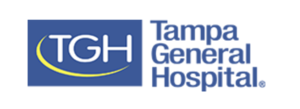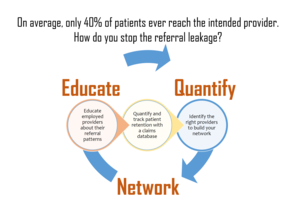Physician Relations: The Secret to Keeping Patients in Your Network
// By Lisa D. Ellis //

Katie Alexander, director of physician relations at Tampa General Hospital
Close examination of your referral patterns may bring to light some surprising gaps in your current practices that could be impacting your revenues.
That was recently the case at Tampa General Hospital (TGH), says Katie Alexander, director of physician relations at TGH. But once her organization identified the problem using a Physician Relationship Management (PRM) solution that enabled her to track a variety of indicators and add insights from outside data points to paint a clearer picture, she adds that it was easy to find ways to address the issue effectively to boost volume and provide a more coordinated approach to patient care.
Identifying a Problem
TGH is a private, nonprofit hospital that serves as a Level I trauma center for a 12-county radius on the west coast of Florida. It’s also a primary teaching facility for the University of South Florida.
As in most systems, Tampa’s electronic medical records were not always capturing the detailed path that led patients to the hospital for treatment, according to Alexander. With the hospitalist model used at TGH, it was often unknown who referred the patient to seek care. On the flip side, there was also no formal method to track affiliated physicians’ referral patterns. Complicating matters is that the health system employs only a small physicians group. This means that most affiliated physicians have a choice of where to send their patients, elevating the importance of strong physician-management relationships to keep patients in the system.
To understand the untapped opportunities, as well as areas that need more improvement, Alexander analyzes third-party claims and identifies referral patterns.
Painting a Picture Using Data
 What she discovered after analyzing the data is that many of the physicians in the health system’s own clinics were sending patients outside of the Tampa network when it came time to see specialists.
What she discovered after analyzing the data is that many of the physicians in the health system’s own clinics were sending patients outside of the Tampa network when it came time to see specialists.
“I began looking at the referral patterns in January until March of 2016, then I developed a report that showed referral patterns by location, focusing on our 14 [affiliated] clinics and looking at referrals by each physician to see what percent of their downstream revenue came to us,” she says. After reviewing the three months of data, she shared it with Tampa’s leadership and also with the head of each practice. Then she met with physicians to share the results and to try to understand the reasons patients were being referred outside the system.
“What we learned through the process is that no one was intentionally sending patients to our competitors,” she says.
The reasons for referring outside of TGH ranged from clinicians not personally knowing the specialists in the system, to not knowing which specialists were actually affiliated with the hospital (at TGH, surgeons don’t have to be members of the medical staff to practice there), to wanting to leave the decision of where to seek follow-up care from a specialist up to the patient.
The Need for Education
 Armed with this information, Alexander and a team of five physician relationship representatives set out to educate their clinicians about why it is important to keep patients in network, such as to keep volume flowing, to keep the health system profitable, and to provide more coordinated care with physicians and specialists by taking a team approach.
Armed with this information, Alexander and a team of five physician relationship representatives set out to educate their clinicians about why it is important to keep patients in network, such as to keep volume flowing, to keep the health system profitable, and to provide more coordinated care with physicians and specialists by taking a team approach.
“We also provided opportunities for our employed primary care providers to meet with specialists in our network so now they will feel more confident referring to them,” Alexander says.
The physician relations team also educated office staff at each clinic, since they also often handle the referral process. This way everyone was up to speed on the importance of coordinating patient care more closely with affiliated clinicians.
Further, TGH produced a book of referral options so it is easy to check and see which providers are part of their health system. This book is updated regularly to keep information current.
Tracking Success
These simple—but effective—changes have led to significant results. “Just by educating the physicians and providing them with the networking opportunities with our specialists, we have improved our loss of downstream revenue by 28 percent in 6 months,” Alexander says.
Interestingly enough, without investing in a PRM and exploring different data points and trends, TGH would not even have known it was missing potential referrals. “Our numbers were steady per month and per year,” she recalls. Therefore, without access to third-party claims data, the issue was not obvious.
While resolving the referral problem has been effective, Alexander says that she had to overcome challenges in the process. The biggest issue was that third-party claims data is never 100 percent accurate. “No tool is, though,” she says. “The way I managed this problem was by just admitting the limitation in the data right upfront every time I showed it to a provider or administrator. I would say it is not a 100 percent picture of referral patterns, but more like a 70 to 80 percent capture rate, but this is significant accuracy based on what we had five years prior.”
To put this into perspective, Alexander adds, “that 28 percent [decrease in revenue, lost due to missed referrals] was equivalent to $18 million—so even if I’m 70 percent accurate, the value of 70 percent of $18 million is enough to stake your best in this.”
Recouping the Investment
She says that for other health care organizations that have not yet invested in a tool to manage physician relations and access claims data to understand referral patterns, it is certainly worth considering delving into this area.
“Tools are expensive, but our investment allows our physician relations department to single-handedly come up with a return on the investment. For instance, in 2016, my department could show 103 percent ROI thanks to going this route,” Alexander says. Her department can look at a doctor who never sent a referral in the system and can go meet with him and then track his patterns after the meeting to show when referrals start coming in.
Exploring Marketware’s PRM
TGH’s success using a comprehensive PRM can serve as an example to other groups, says Josh Cameron, a client success manager at Marketware, which provides a cloud-based PRM and analytics tool that health systems like TGH can use to strengthen physician relations and gain other insights to guide their operations in a more strategic way.
But finding the right system is only half the battle, Cameron says. “When organizations invest in a product like Marketware provides, they also need to invest in a person to lead the efforts to use it to its full advantage,” he points out. TGH’s example demonstrates the value of having a partner experienced in physician relations and analytics technology.
Cameron also knows firsthand the importance of having someone in charge of learning how to use a PRM to its full advantage. Prior to joining the Marketware staff in April, he was actually a Marketware client who used this software to guide a Houston-based oncology group, where he had a chance to see the benefits up close.
“What I found makes Marketware unique from other competitors I explored was that it brings together physician data, claims data, and field intelligence so clients can pull all three of these elements together to create a story,” Cameron says. “This allows our clients not only to see what is lacking, but they can also plan their next step and act on it.”
And as TGH found, when these perspectives are added together, the results can equal measurable success.
Lisa D. Ellis is editor of Strategic Health Care Marketing. She is a journalist and content development specialist who helps hospitals and other health care providers and organizations shape strategic messages and communicate them to their target audiences. You can reach her at editor@strategicHCmarketing.com.
